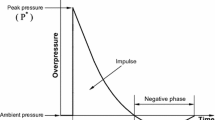Abstract
The object of this analysis is to investigate the mitigation effects of watershield on blast waves numerically. One application of current work is to resolve the design concerns for the ammunition storage facilities. To verify the numerical procedure using a multimaterial Eulerian finite element method, the results are compared with the available experimental data for detonation in a pressured tank, and the analytical predictions for air shocks. Features of the free-field detonation process are then studied from a series of one-dimensional simulations. The magnitude of peak pressure decreases and shock arrival time increases with increasing thickness of watershield. For design analysis, the case of two-dimensional axisymmetric geometry (a vertical) right-circular cylinder) with a central charge is also considered. The full process including initial detonation, shock wave propagation and reflection from the outer rigid boundary is examined. For the explosives immersed in water, the magnitude of peak pressure becomes smaller than those in air tank without watershield. At later time period, the average gas pressure left in the air tank is about 20 bar.
Similar content being viewed by others
Abbreviations
- A,B :
-
Contstants in JWL equation
- a1,a2,a3:
-
Contstants in polynomial EOS
- b1,b2,b3:
-
Contstants in polynomial EOS
- C o :
-
Sound speed at undisturbed state
- E :
-
Specific internal energy per unit mass
- P :
-
Pressure
- R1,R2:
-
Contstants in JWL equation
- S1,S2,S3:
-
Coefficients of the slope ofU s −u p curve
- t :
-
Initial explosive thickness
- t a :
-
Shock arrival time
- U s :
-
Shock velocity
- U p :
-
Fluid particle velocity
- x o :
-
The largest cell thickness
- x i :
-
The smallest cell thickness
- w :
-
Watershield thickness
- Z :
-
Scaled distance (m/kg1/3)
- γ:
-
Ratio of specific heats
- η:
-
compression radio (ρ/ρ o )
- μ:
-
η−1
- ϱ:
-
density
References
Baker, W. E., 1973, Explosions in Air. University of Texas Press, Austin USA.
Chisum, J. E. and Shin, Y. S., 1997, “Explosion Gas Bubbles Near Simple Boundaries,”Journal of Shock and Vibration, Vol. 4 (1), pp. 11–25.
Dobratz, B. M., 1981, LLNL Explosive Handbook, UCRL-52997, Lawrence Livermore National Laboratory, Livermore, CA. USA.
Fusheng, L., **anmong, C., Pansen, C., Juxing, C., Hua, T., Qingquan, G., and Fuqian, J., 1996, “Equation of State and Conductivity of Shocked Heavy Water,”Shock Compression of Condensed Matter, pp. 57–60, American Institute of Physics.
Hansson, Hakan and Forsen Rickard, 1997, “Mitigation Effects of Water on Ground Shock: Large Scale Testing in Alvdalen,”FOA-R-97-311, Defense
Research Establishment, Weapons and Protection Division, S-172 90, Stockholm, Sweden.
Keenan, W. A. and Wager, P. C., 1992, “Mitigation of Confined Explosion Effects by Placing Water in Proximity of Explosions,”Presented at the 25 th DoD Explosives Safety Seminar, Anaheim, CA.
Kinney, G. F. and Graham, K. J., 1985, Explosive. Shocks in Air. Second Edition, Springer-Verlag.
Lalle, R. C., 1996, “Dynamic Properties of Water: Sound Velocity and Refractive Index,”Shock Compression of Condensed Matter, pp. 61–64, American Institute of Physics.
Mitchell, A. C. and Nellis, W. J., 1982, “Equation of State and Electrical Conductivity of Water and Ammonia Shocked to the 100 GPa (1Mbar) Pressure Range,”Journal of Chemistry and Physics, Vol. 76 (12), 15 pp. 6273–6281.
MSC/DYTRAN User's Manual, 1994, MSC/DYTRAN Version 2.2, MacNeal-Schwendler Corporation, Los Angeles, CA. USA.
Rice, M. H. and Walsh, J. M., 1957, “Equation of State of Water to 250 Kilobars,”Journal of Chemistry and Physics, Vol. 26, No. 4.
Steinberg, D. J., 1987, “Spherical Explosions and the Equation of State of Water,”Report UCID-20974, Lawrence Livermore National Laboratory, Livermore, CA. USA.
Weingarten, L. I., Horstemeyer, M. F. & Trento, W. P., 1992, “Modeling Underwater Explosions with an Eulerian Code,”Proceedings of the 63rd Shock and Vibration Symposium, pp. 269–277.
Author information
Authors and Affiliations
Rights and permissions
About this article
Cite this article
Lee, M., Shin, Y.S. Investigations of the watershield effect on blast waves: One and two-dimensional study. KSME International Journal 13, 191–199 (1999). https://doi.org/10.1007/BF02943671
Received:
Issue Date:
DOI: https://doi.org/10.1007/BF02943671




